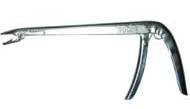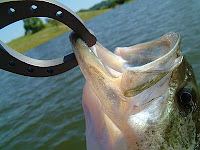
Many anglers at Bow Narrows Camp prefer to troll for walleyes and northern pike. This method works great and allows a person to cover more territory than he or she would by casting or jigging.
There are two distinctly different methods of trolling when it comes to walleye fishing. There is backtrolling with Little Joe type spinners or Lindy Rigs and there is front trolling with crank baits.
Back trolling (trolling the boat in reverse) allows you to make a slow presentation and this is always the best idea when using live bait rigs. You want to use enough weight on your line so that you are "bumping" your rig on the bottom, at least every few minutes. (See Red Lake Walleyes Everywhere.)
Our 20 hp Honda four-stroke outboards idle very slowly, produce no smoke like the old two-stroke outboards, and are so quiet you can barely tell they are running when idling.
If it is windy, you may need to troll frontwards, even when bait fishing, to prevent waves from splashing over the transom while backtrolling. Or you can backtroll when going downwind and front troll when going upwind while working a productive spot.
Front trolling is usually always the best way to fish crank baits. This is true both for walleyes and northern pike. Rapala, Cotton Cordell, Bagleys and many others work well on Red Lake.
Use models that are 3-7 inches in length. Ones with small lips run shallow and ones with big lips dive deep. Shad Raps and lipless Rattle Traps and Rattling Raps and similar lures are great.
When trolling shorelines the person fishing on the shore side can use a shallow runner and the person fishing on the opposite side can use a lure that dives a little deeper. You want the lure to be fairly close to the bottom.
It is best not to use a weight when using crank baits as the sinker interferes with the action of the lure. Just choose the lure that runs to the correct depth.
Back trolling with bait can be done with the same light weight rods and reels described in Lighten Up for Northern Pike.
Front trolling with crank baits could require slightly heavier equipment (but don't get carried away. We're not talking about deep sea fishing!) A medium action rod and spinning reel with 10-12 pound test should do it. The line can be mono or the new braided lines like Spider Wire. The braided lines have the advantage of providing more "feel" since they do not stretch. This helps you distinguish between the bottom and a fish. They also let you set the hook better when you have a lot of line out behind the boat.
Lots of people do a combination of trolling and casting and jigging. They troll until they locate a school of fish, then switch to casting and jigging.
Click to go back to our website
Click to see the latest on the blog




